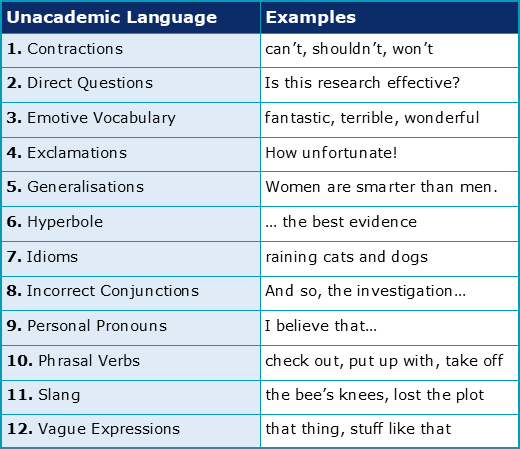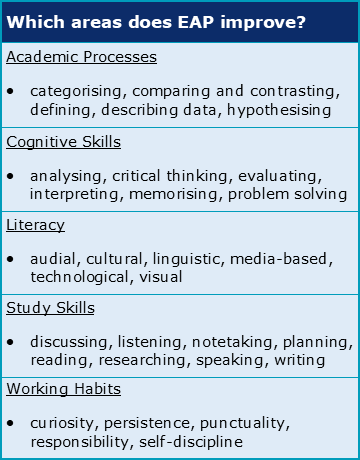What is English for Academic Purposes (EAP)?

This is the first of three chapters about Academic Language. To complete this reader, read each chapter carefully and then unlock and complete our materials to check your understanding.
– Introduce the concept of English for Academic Purposes
– Discuss the types academics that use EAP with frequency
– Provide the most common academic and unacademic language structures available to students
Before you begin reading...
-
video and audio texts
-
knowledge checks and quizzes
-
skills practices, tasks and assignments
Chapter 1
Regardless of which language a student might use to conduct their studies, the completion of a university-level assignment will require a certain style and register of language that some new academics may be unfamiliar with at first. Whether a speaker is native or is learning the language for the purposes of academia, students who are completing a bachelor’s or master’s degree in English should quickly become familiar with the term English for Academic Purposes – or ‘EAP’. Broadly speaking, EAP describes the type of academic language that English-speaking students will be required to use if they wish to write in the appropriate style.
This short reader on academic language has therefore been created to introduce students to the overall concepts of language appropriacy, hoping to explain the many dos and don’ts of this style so that new academics can improve the quality of their assignments and in turn increase their overall grades. Our first chapter on this topic explores the concepts and features of English for Academic Purposes, with Chapter 2 introducing the seven language structures that are most appropriate when writing academically. Chapter 3 then concludes this readers by outlining the twelve types of linguistic construction that are generally considered to be too informal, subjective or imprecise to be included in academic research.
Who uses English for Academic Purposes (EAP)?
Although some estimates for the number of people studying the English language are as high as 1.5 billion, the amount of students, teachers and researchers who are required to use English for Academic Purposes is undoubtedly much lower. While non-native students of English may have many reasons for studying the language (whether it’s a desire to improve their ability to travel, their job prospects, or their understanding of foreign movies and music), users of academic English generally all have the same motivation – which is to emulate the correct and appropriate form, style and register of English that’s conventionally used when submitting, tutoring or publishing successful academic research. This more limited motivation of course explains the lower number of learners around the globe. In truth, however, and as the following table shows, there are still thousands (if not millions) of English speakers for whom academic language is vital to their success – whether they recognise this language as having a distinct style or not:

English for Academic Purposes, then, is the particular language that’s required for successful integration into the academic community, covering areas of grammar, punctuation, syntax, vocabulary and appropriate discourse. EAP is, in short, the written or spoken forms that are most useful to students when attempting to complete academic assignments, improve academic skills, understand academic policies and navigate academic norms.
Which language is academic?
Students of EAP must quickly become familiar with the idea that language is context dependent, meaning that the words and structures a speaker selects may vary from situation to situation. As can be seen in the following examples, the formal and often archaic (old-fashioned) language used between a defendant and a judge within a courtroom for example may be quite different from the informal, colloquial language used between two young friends in the school playground:


Similarly, while general English may be described as being informal and subjective in nature, academic English is traditionally more formal and objective – preferring scientific methods of persuading the reader, such as by offering reasoning, deduction, evidence and analysis. Academic language is therefore intended to be as precise, unambiguous and concise as possible, so that important information can be transmitted from the writer or speaker to their audience with as little opportunity for misinterpretation as possible.
As will be explored in considerable detail in Chapters 2 and 3, there are a number of language structures and techniques that can be both utilised and avoided by students to improve the appropriacy of their language. To begin recognising these forms, we’ve listed examples of both academic and unacademic language below:


How can academic language benefit students?
Students of EAP should not only recognise and use (or avoid) these language structures but they should also understand how such language can benefit them when completing certain tasks, such as writing an essay, giving a presentation, or sitting an exam. Not only will following academic style and register directly improve a student’s grades, but it should also assist them when attempting to organise their ideas, describe complex concepts and processes or explain abstract ideas and theories. To clarify the most useful functions, skills and habits for you, we’ve provided a table below that outlines the five key areas that should be improved through the consistent and purposeful acquisition of academic English:

To reference this reader:
Academic Marker (2022) Academic Language. Available at: https://academicmarker.com/academic-guidance/vocabulary/academic-language/ (Accessed: Date Month Year).
Downloadables
Once you’ve completed all three chapters about academic language, you might also wish to download our beginner, intermediate and advanced worksheets to test your progress or print for your students. These professional PDF worksheets can be easily accessed for only a few Academic Marks.
Collect Academic Marks
-
100 Marks for joining
-
25 Marks for daily e-learning
-
100-200 for feedback/testimonials
-
100-500 for referring your colleages/friends